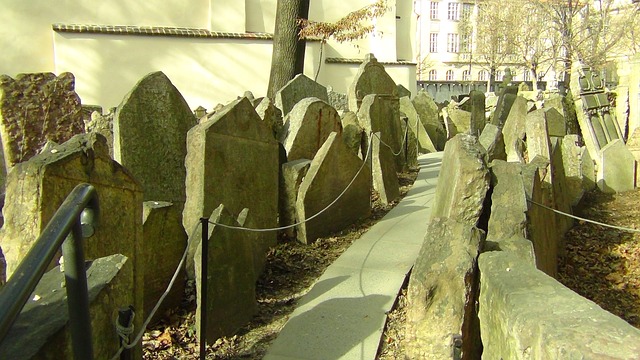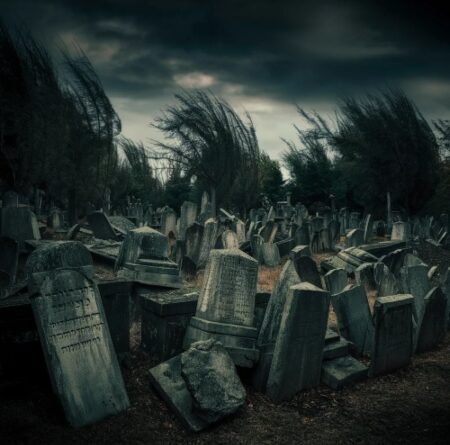The Creepy Chaos of Prague Old Jewish Cemetery
The Jewish history of Prague is rich and includes quite a few particularly chilling moments. Wandering through Prague’s Jewish historical sites is a must, and not just for those whose blood is blue and white. There is no doubt that the most important site – and unfortunately also the scariest and most chilling – is the Jewish Cemetery in Prague (known as the Old Jewish Cemetery In Prague), which proves that sometimes reality surpasses any horror movie.
What Is The Old Jewish Cemetery In Prague?
The ancient Jewish cemetery in Prague is located on the edge of Josefov, aka the Jewish quarter of the city. Despite what his name may imply, he is not the oldest Jewish Cemetary in Prague. It was preceded by the “Jewish Garden” cemetery, which was found only later as part of archaeological excavations in what is now known as the New Town of Prague.
The first thing you feel when you enter Prague’s ancient cemetery is chaos or at least a feeling that something is wrong here. The sense of horror rises when you realize how many people were “buried” here if you can call it that. Around 12,000 gravestones are scattered within the cemetery, densely and sometimes in a chaotic way. However, according to estimates, the remains of more than 100,000 Jews are buried here. Most of them died as a result of the epidemic and the overcrowding and poor living conditions that characterized the Jewish community at the time.
Even today when visiting The Cemetery, it is difficult not to feel a certain sense of suffocation due to the large number of headstones, and their uneven organization in space. The trees within the old Jewish Cemetery Prague create an impression that we are in the forest and not in one of the busiest and most tourist cities in Europe.

When There Is No Place In The Cemetery, The Dead Will Be Buried Upwords
The question we all need to ask is how exactly hundreds of thousands of people are buried in a relatively small number of gravestones. If in the case of the Paris Catacombs the solution to the burial of millions of people was a network of tens of kilometers of underground tunnels, here the solution was slightly different.
First, Since there is no such infrastructure in Prague. Second, according to Jewish tradition, it is forbidden to change the location of a body from the moment it was buried. The Jewish community, therefore, did not have the option of purchasing additional land, so the burial was done upwards. Each time the tombstone was filled, layers of soil had been placed on top of existing graves, on top of which old tombstones were placed, sometimes at different angles. This happened again and again, which partly explains the density and lack of uniformity that characterize Prague Cemetery Jewish.
The oldest tombstone preserved in the Jewish cemetery of Prague is of Rabbi Avigdor Kara, the poet and thinker, from 1439. However, it is very likely to assume that they buried people at the Jewish cemetery in Prague even earlier. Within the boundaries of the cemetery is the grave of Rabbi Yehuda Liwa ben Bezalel, better known as the “Maharal of Prague”. He is considered one of the great rabbis and kabbalists of Israel in modern times and the unofficial leader of the city’s Jews, perhaps at the same time as the “official” head of the community, and he is Mordechai Meisel ( He is also buried in this cemetery).
The burial in the cemetery was done until the end of the 18th century, or more precisely in 1787. During this period, the Jewish dead began to be buried in the Jewish cemetery Žižkov in the suburbs of Prague. Then, at the end of the 19th century, the burial took place within the boundaries of the new Jewish cemetery in Prague, which already had room for 100,000 graves. Franz Kafka, among others, is buried in this cemetery, and it is still in use today.

Meet The Ghosts Of Prague
Likewise other ancient cities, Prague also has ghost stories: some are related to the Jewish community, and a small part to the Jewish Cemetry Prague.
The most famous myth is, of course, the Golem from Prague. The Maharal from Prague is the one who, according to the well-known folk legend, created the creature from clay that he collected from the banks of the Vltava river. The Golem had superhuman powers that arose to deal with the blood plots that were spread against Jews in ancient times, especially during the terrible times of Rudolph II who wanted to unite the country around Christianity and saw Judaism as an obstacle on the way to that.
A piece of parchment inserted under The Golem’s tongue, with the name of God on it, activated it. The Golem was meant to do what he was told to So that on the days when they were fixed he took a central part in the housework. Every week, before the Sabbath, The Maharal would take the life out of the golem, by removing the parchment, to prevent the desecration of Shabbat.

One week he forgot, and the Golem got angry. He took to the streets of Prague, destroying every good part and harming the residents. In the end, the Maharal managed to neutralize the threat by removing one of the letters on the golem’s forehead (“Truth”). The inscription became “dead” and the golem broke into pieces. Legend has it that his spirit is still in the attic of the Altneushol Synagogue, located in the Jewish Quarter in Prague. Not far away from Prague Jewish Cemetery.
The Golem of Prague has been mentioned in a few films. In 2019, “The Golem”, an independent and low-budget horror film, was released in a limited way in several cinemas overseas and was sold to Netflix. The film tells the story of a young woman in a Jewish Europe community (in that case, Lithuania). To protect the Jewish community from those who seek to harm it, in a time of a destructive epidemic that threatens its existence, it creates a figure of a child that gets one day out of control. If we go back, one of the theories is that the folk legend surrounding the Golem from Prague was one of the clear inspirations for horror stories like Frankenstein.
In Prague, there are other ghosts that, according to the stories, belong to Judaism. One of them is “The Dancing Jewess”, an escort girl who was whipped to death during Good Friday. Now she returns every year on this Christian holiday, dancing men to their deaths.
If you believe in ghosts you might also encounter the late hooded organist. According to the story, he converted. After his death, he returned to Christianity. Today he gets up among himself at eleven at night and goes to the St. Vitus Cathedral, accompanied by a skeleton-shaped cross and sometimes also a black cat (his wife, but who?). These are only a part of more than a dozen “Jewish” ghosts who live in Prague or rather die there. You can get to know these kinds of stories as part of one of the ghost tours of Prague, but to visit the Old Jewish Cemetery of Prague and learn about it you will have to take a separate tour.
How Do You Visit The Old Jewish Cemetery In Prague?
The Old Jewish cemetery in Prague is located near other historical sites related to the extensive Jewish community in the city, and it is customary to visit several sites one after the other. It is part of the Jewish Museum in Prague, which includes several synagogues – the Sephardic Synagogue, the Meisel Synagogue, the Pinx Synagogue, and the Klausen Synagogue – as well as Purgatory and other buildings where Judaica objects are displayed.
You can visit the entire complex as part of an organized tour, which also includes the ancient Jewish cemetery of Prague.
Old Jewish Cemetery Prague Opening Hours
The Old Jewish Cemetery in Prague is open every day of the week, except Saturday and Jewish holidays. The usual opening hours are from 9:00 a.m. to 6 p.m. between April to October, and from 9:00 a.m. to 4:30 p.m. from November to March.
Old Jewish Cemetery Prague Entrance Fee
A ticket for the Old Jewish Cemetary, along with the biggest synagogues, should cost around 300 Czech Crowns. The fact that you should buy Old Jewish Cemetery tickets (except in cases where you go to the grave of a family member, in which the visit will be at no charge by prior arrangement with the Jewish Museum’s secretariat) is a source of quiet a few criticisms. The cemetery may evoke some feelings of neglect, so some people don’t think it’s “worth the money”. The fact that almost all the other sites scattered around the Jewish quarter in Prague require a fee, including the synagogues, contributes to these feelings.

The Old Jewish Cemetery in Prague has two walking tracks, one for the summer and the other for the winter months, and marked paths that tourists asked to stick.
Old Jewish Cemetery In Prague Guides
We recommend joining guided tours, for example, the popular tour that includes all the sites of the quarter and the Jewish Museum. The reason is that without a formal guide, it’s pretty hard to understand what you see. A large part of the graves at Prague Jewish Cemetery, even the most important ones, are not properly marked: we heard of quite a few people who came specifically to place a note or a stone on the grave of the Maharal in Prague, in a grave that is considered a kind of local “Kotel”, but they simply could not find the grave. What’s more, the interesting stories concerning the Jewish community and the people buried here.
You can find different many walking tours on the Old Jewish Cemetery in Prague, most of them are part of a broader tour in the Jewish Quarter:
Some of the links on this site are affiliate links. That means if you purchase through them, we might earn a small commission. But don’t worry... it won’t cost you extra, and it probably won’t summon anything...
So if you’re thinking of buying something… don’t be afraid to click! 🔪👁️






